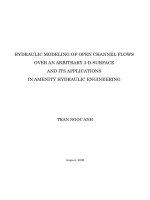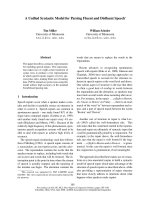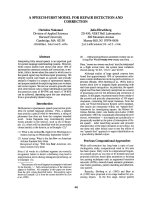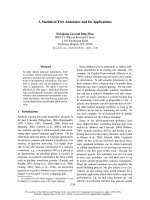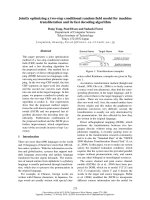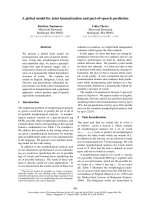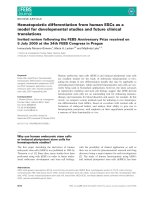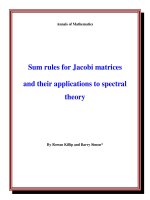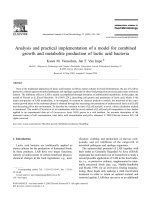Workload model for video decoding and its applications
Bạn đang xem bản rút gọn của tài liệu. Xem và tải ngay bản đầy đủ của tài liệu tại đây (2.62 MB, 116 trang )
Workload Model for Video Decoding and Its
Applications
Huang Yicheng
Submitted in partial fulfillment of the
requirements for the degree
of Doctor of Philosophy
in the School of Computing
NATIONAL UNIVERSITY OF SINGAPORE
2008
ii
©2008
Huang Yicheng
All Rights Reserved
iii
Acknowledgments
I would like to take this opportunity to express my sincere thanks to many people,
without whom this dissertation would not have been possible.
My foremost thanks go to my supervisor, Assistant Professor Wang Ye, who has had
great impact on me. Over the past four years, he has set a good example for me to have
great passion and a serious attitude about research. He has helped me overcome my
shortcoming, set achievable objectives at each step, and kindled aspiration in my heart.
Without him, this thesis would never have been completed. My gratitude also goes to
Assistant Professor Ooi Wei Tsang and Assistant Professor Chan Mun Choon, who are
members of my evaluation committee. They have provided me with valuable feedback to
refine my research work. I would like to thank many friends in National University of
Singapore for the inspiring discussions that have contributed to my research work and the
many enjoyable hours we spent together for the leisure time. They are Tran Vu An,
Huang Wendong, Hong Guangming, Zhu Zhehui, Zhang Bingjun, Gu Yan, Ni Yuan, Yu
Jie, Liu Chengliang and Guo Shuqiao. I have really enjoyed the collaborations and
discussion with these brilliant people.
Finally, I feel deeply indebted to my family members. Even though they know nothing
about my research topic, they have listened to my explanation of the topic and
encouraged me to pursue my dream. There are no words to thank them for that.
iv
Contents
Acknowledgments iii
Contents iv
List of Figures vi
List of Tables ix
Abstract x
Chapter 1: Introduction 1
1.1 Background 1
1.2 Challenges 6
1.3 Structure of Thesis 8
1.4 Main Contributions 8
Chapter 2: Background and Related Work 10
2.1 Introduction 10
2.2 MPEG Video Format 10
2.3 Decoding Workload Model 12
2.4 Energy Saving Schemes for Mobile Video Applications 15
2.5 Objective Video Quality Measure 19
Chapter3: Decoding Workload Model 23
3.1 Video Decoding Procedure 23
3.2 Decoding Workload Model and Analysis 24
3.2.1 VLD, IQ and DC-AC Prediction Tasks 24
3.2.2 IDCT Task 29
3.2.3 MC Task 32
3.2.4 Total Workload 34
3.3 Evaluation 34
3.3.1 Experiment configuration 35
3.3.2 Results and Analysis 36
3.4 Summary 42
Chapter 4: Workload-Scalable Transcoder 43
4.1 Introduction 43
4.2 Workload Control Scheme 47
4.3 Mean Compressed Domain Error 50
4.3.1 Spatial Distortion 52
4.3.2 Temporal Distortion 53
v
4.3.3 Total Distortion 55
4.4 Evaluation 57
4.4.1 Mean Compressed Domain Error Evaluation 57
4.4.2 Transcoding Scheme Evaluation 62
4.4.3 Experiment configuration 63
4.4.4 Workload Control Evaluation 63
4.4.5 Candidate Selection Evaluation 64
4.5 Summary 66
Chapter5: Workload Scalable Encoder 67
5.1 Introduction 67
5.2 Frame Rate Selection Scheme 70
5.3 Workload Control Scheme 77
5.4 Evaluation 81
5.4.1 Workload Control Scheme Evaluation 81
5.4.2 Frame Rate Selector Scheme Evaluation 86
5.5 Summary 90
Discussion and Future Works 91
References 95
vi
List of Figures
Figure 1.1, Improve multiple since 1990 (quoted from [68]) 2
Figure 2.1 DVS system architecture 17
Figure 3.1 The decoding process of MPEG-2 video 23
Figure 3.2 Workload generated by VLD task of the reference MPEG-2 decoder 25
Figure 3.3 Workload generated by VLD task of the MPEG-4 decoder 26
Figure 3.4 Processor cycles distribution of the DC-AC Prediction task of reference
MPEG-4 decoder 28
Figure 3.5 Processor cycles distribution of the IDCT task of reference MPEG-2 decoder
30
Figure 3.6 Processor cycles distribution of the IDCT task of reference MPEG-4 decoder
31
Figure 3.7 Processor cycles distribution of the MC task of the reference MPEG-2
decoder 32
Figure 3.8 Processor cycles distribution of the MC task of the reference MPEG-4
decoder 32
Figure 3.9 Cumulative prediction error rate of the decoding workload model, on Laptop
(1
st
run) 37
Figure 3.10 Cumulative prediction error rate of the decoding workload model, on Laptop
(3
rd
run) 37
Figure 3.11 Cumulative prediction error rate of the decoding workload model, on
SimpleScalar (1
st
run) 38
Figure 3.12 Cumulative prediction error rate of the decoding workload model, on
SimpleScalar(3
rd
run) 38
Figure 3.13 Cumulative prediction error rate of the decoding workload model, on PDA
(1
st
run) 39
vii
Figure 3.14 Cumulative prediction error rate of the decoding workload model, on PDA
(3
rd
run) 39
Figure 3.15 the comparison between our model and the history-based model 41
Figure 4.1 System architecture for the transcoding scheme 44
Figure 4.2 Transcoding Scheme 45
Figure 4.3 The correlation between MCDE and subjective result with different values
56
Figure 4.4 comparison among MCDE, MSE and DSCQS for Hall_768 with 15fps 59
Figure 4.5 comparison among MCDE, MSE and DSCQS for Highway_1024 with 50%
Huffman codes 60
Figure 4.6 Comparison among MCDE, MSE and DSCQS for Walk_512 with 8fps 61
Figure 4.7 The comparison for the actual decoding workload and workload constraint .64
Figure 4.8 Comparison between the MCDE and 1/Actual PSNR 64
Figure 4.9 Accuracy of the candidate selection 65
Figure 5.1 The encoder architecture 69
Figure 5.2 An example case for frame rate selection scheme 71
Figure 5.3 the distortion calculation for P’(i,j) 74
Figure 5.4 The Comparison between the constraint and actual decoding workload for
sequence ‘akiyo’ 82
Figure 5.5 The Comparison between the constraint and actual decoding workload for
sequence ‘hall’ 83
Figure 5.6 The Comparison between the constraint and actual decoding workload for
sequence ‘coastguard’. 83
Figure 5.7 The Comparison between the video distortions between different workload
control schemes for the sequence ‘hall 85
Figure 5.8 The Comparison between our scheme and MSE for the sequence
‘bridgeclose’ 87
viii
Figure 5.9 The Comparison between our scheme and MSE for the sequence ‘coastguard
87
Figure 5.10 The Comparison between our scheme and MSE for the sequence ‘container
88
Figure 5.11 The complexity comparison between the two schemes 89
ix
List of Tables
Table 3.1 12 CIF raw videos 35
Table 4.1 Video sequence used to compare MCDE, MSE and DSCQS 58
x
Abstract
.
In recent years, multimedia applications on mobile devices have become increasing
popular. However, to design a mobile video application is still challenging due to the
constraint of energy consumption. According to previous studies, the energy consumption
of the mobile processor is cubic to its workload. For a mobile video application, it is
therefore desirable to control decoding workload so that energy consumption by the
processor may be reduced.
In this thesis, we study the relationship between decoding workload and video quality.
Based on the analysis of video structure and decoder implementations, we propose a
decoding workload model. Given a video clip, the model can accurately estimate the
decoding workload on the target platform with very low computational complexity.
Experiments are conducted to test the robustness of the model. The experiment results
show that the model is generic to different decoder implementations and target platforms.
We also propose two relevant video applications: the decoding workload scalable
transcoder and the decoding workload scalable encoder. Based on the decoding workload
model, the proposed transcoder / encoder is able to generate a video clip which matches
the decoding workload of the client while striving to achieve the best video quality. The
transcoder /encoder can also balance the tradeoff between frame rate and individual
frame quality, i.e., given a workload constraint, the transcoder / encoder can determine
the most suitable frame rate /and individual frame quality combination even before the
xi
actual transcoding / encoding. We achieve this by proposing two novel compressed
domain video quality measures.
xii
To my parents
1
Chapter 1
Introduction
1.1 Background
After a decade of explosive growth, mobile devices today are increasingly becoming
important entertainment platforms for video and multimedia content. This application
scenario is a fast emerging area with huge economic impact. However, supporting
multimedia applications on mobile devices is more challenging due to constraints and
heterogeneities such as limited battery power, limited processing power, limited
bandwidth, random time-varying fading effect, different protocols and standards, and
stringent quality of service (QoS) requirements.
Energy consumption is a critical constraint for a mobile video application. For years, chip
makers have focused on making faster processors. Following Moore's Law, the
processor’s processing power would double every two years. However, the development
of the battery has not improved as fast as that of the processor. As Figure 1.1 [68], CPU
speed double per 18 months while battery energy density doubles per 12 years.
2
Figure 1.1 Improvement since 1990 (quoted from [68])
The battery of a typical mobile device such as a PDA or a mobile phone can only support
video playback for about four hours. With streaming, battery lifespan will be even shorter
as receiving data from a network requires substantial power. As a result, a mobile device
has to minimize its energy consumption to prolong its battery life and attain suitable
levels of quality of service at the same time.
Energy saving can be done at three levels in the computer system hierarchy: hardware,
operating system and application. Energy at hardware level saving is out of the scope of
this thesis. The advantage of saving energy at the operating system level is that the
operating system has knowledge of the whole machine status, and so it can manage
3
energy consumption efficiently. This is why most energy saving schemes are done at this
level [46, 47]. However, the operating system functions at a low level in the computer
system hierarchy, and it therefore does not have knowledge of applications or users’
behavior. This renders energy saving schemes at the operating system level incapable of
adapting to different application scenarios or users’ preferences. On the contrary, energy
saving schemes at the application level know about the applications and users’ behaviors,
and are therefore able to make tradeoff between quality of service and energy
consumption. For example, in a mobile video application, when energy is plentiful,
application behavior should be biased toward good user experience: displaying video at a
high frame rate / resolution; when energy is scarce, the behavior should be biased toward
energy conservation: displaying video at a low frame rate /resolution. The problem is:
how low should the frame rate / resolution be? On one hand, we know energy can be
saved by sacrificing quality of service; on the other hand, we do not want to compromise
too much on quality – the quality should still be acceptable. Ideally, therefore, quality
should be optimized based on the available resources. From this aspect, a mobile video
application design can be regarded as an optimization problem under multiple constraints.
To solve such a problem, mathematical models between video quality and constraints
should be established. For example, for the constraint of bandwidth, rate-distortion (R-D)
models have been studied for decades. However, the current state of the energy-distortion
model is far from satisfactory.
In a mobile device, energy is mainly consumed by three components: wireless network
interface (WNIC), liquid crystal display (LCD) and processor. For WNIC, energy
4
consumption depends on whether the component is in active mode. Network reshaping
schemes have been proposed to make WNIC remain in sleeping mode for as long as
possible [43, 44, 45]. For LCD, it requires two power sources, a DC-AC inverter to
power the cold cathode fluorescent lamp (CCFL) used as backlight, a DC-DC converter
to boost and drive the rows and columns of the LCD panel. Energy is also consumed in
the bus interface, LCD controller circuit, RAM array, etc. [48]. Energy consumption can
be reduced by variable duty-ratio refresh, dynamic color depth control, and brightness
and contrast shift with backlight luminance dimming [49, 50, 51, 52, 53]. The processor,
which is a digital static CMOS circuit, can be calculated by Equation (1.1):
(1.1)
where denotes clock rate (processor frequency), is supply voltage, denotes
node capacitance, and is defined as the average number of times in each clock cycle
that a node will make a power consumption transition (0 to 1) [29]. The relationship
between voltage and processor frequency follows Equation (1.2), based on the alpha-
power delay model [30]:
(1.2)
where is the threshold voltage of the processor, and is the velocity saturation index.
From the above equations, we can calculate the energy consumption of the processor by
5
processor frequency, which can be regarded as the decoding workload for the mobile
video application. Energy consumption can be reduced by adopting dynamic voltage
scaling (DVS) schemes [54] or directly reducing workload.
As energy consumption of the processor can be derived from the decoding workload, we
thus focus on the model between decoding workload and video quality and its relevant
applications in this thesis. The study of the decoding workload model is important
because: 1) As we have mentioned previously, a mathematical model can help us save
energy as much as possible while still provide the quality of service which users prefer. 2)
The model will still apply even if we adopt some operating system level energy saving
scheme, for example DVS. The basic idea of DVS is to scale processor frequency as low
as possible based on workload prediction. Energy can therefore be saved as energy
consumption can be calculated by the processor frequency. However, workload
prediction needs to be accurate. If the actual workload is more than the prediction, the
video cannot be fully decoded, which results in bad quality; if the actual workload is less
than the prediction, the frequency will be scaled too high, which results in a waste of
energy. The model studied in this thesis is able to predict decoding workload accurately,
thereby improving the performance of DVS schemes. 3) Decoding workload itself can
also be a constraint: most existing mobile devices’ processor frequencies are in the range
of 200 MHz to 600MHz. It is difficult for them to decode a video clip encoded by
complex codec technologies such as MPEG-4 and H.264 at a high frame rate (25 – 30fps).
For such cases, our study can help to generate a video clip which meets the constraint of
devices’ processing power while still guarantees quality of service.
6
1.2 Challenges
In studying decoding workload and the relevant video applications, we face three major
challenges:
First, we need to study the relationship between video bitstream and decoding workload.
This is analogous to rate-distortion studies [56, 57, 58, 59, 60], which have found out that
bit rate can be controlled by quantization scale. For decoding workload, we should find
out similar key parameters and establish a mathematical model so that we can control the
decoding workload by adjusting the parameters. The problem is that most existing video
codecs are designed for the rate control. We can establish a model based on the current
video codec’s architecture or propose a new video codec specific to decoding workload
control. In our opinion, designing a new video codec cannot be a practical solution
especially when the new codec is not compatible with existing systems. Hence, in the
thesis, we propose a decoding workload model for existing MPEG video formats and
codecs. The model should be sufficiently accurate and fast. It should also be flexible
enough so that it can be easily applied to different kinds of applications. Moreover, the
model should be generic for adaptability to different video formats, decoder
implementations and platforms.
Second, even with a decoding workload model, designing an application scheme remains
difficult, e.g., to design a video encoder which generates a bitstream under the constraint
of decoding workload. According to previous studies, different frames require different
7
amounts of decoding workload even under the same quality. In some extreme cases, the
decoding workload of one frame can be 10 times different from that of another. If we
allocate workload to frames evenly, quality will differ quite a lot. That results in unstable
user experience. A better approach is to allocate workload based on requirements so that
different frames may be of the same quality. That is why a sophisticated decoding
workload control scheme is necessary. However, the scheme is difficult to design since
the decoding workload requirement is affected by several factors: video content,
encoding algorithm and video format. Taking all these factors into consideration makes
the scheme very complex. Moreover, an objective measure for estimating the quality of
the encoded frames or MBs is not available before the frames or MBs are actually
encoded. This makes scheme design even more difficult.
Third, we need to consider the tradeoff between individual frame quality and frame rate.
In traditional video applications, the frame rate is fixed at 25 or 30 frames per second, i.e.,
the decoder decodes a frame every 1/25 or 1/30 second. However, in mobile video
applications, some mobile devices’ processing power is so low that they cannot decode a
normal quality frame properly within that time slot. Therefore, to fix the frame rate at 30
or 25 fps in the mobile application may not be feasible. To overcome the constraint, we
can either reduce the frame rate or the quality of individual frames. The problem is, we
may have more than one combination of frame rate and individual frame quality with the
same decoding workload. To provide the best quality of service, we need to select the one
with the best quality among them. Therefore, an objective measure is necessary to
evaluate the quality of all the options.
8
1.3 Structure of Thesis
The rest of the thesis is organized as follows: A reader without knowledge about mobile
video application design may want to refer to Chapter 2 for some background knowledge
and related work, including that on MPEG video format, decoding workload model,
existing energy saving schemes and objective video quality measures. In Chapter 3, we
present our decoding workload model and evaluate it using different decoders on
different target platforms. Based on the model, we propose two decoding workload
related mobile video applications in Chapters 4 and 5. In Chapter 4, we propose a
workload-scalable transcoder which works in the compression domain. It reduces the
decoding workload by dropping either Huffman codes or frames. To evaluate the tradeoff
between Huffman codes and frames, we propose mean compression domain error
(MCDE), a compression domain video quality measure designed for transcoding
applications. In Chapter 5, we propose a workload-scalable encoder. It includes two
schemes: the frame rate selection scheme and the workload control scheme. The frame
rate selection scheme selects the most suitable target frame rate before actual encoding;
the workload control scheme controls decoding workload under the constraint. In Chapter
6, we conclude the thesis and present future directions.
1.4 Main Contributions
The major contributions of the thesis lie in three aspects:
9
First, we analyze the relationship between video quality and decoding workload, based on
which we establish a mathematical decoding workload model. The experiments show that
the model is accurate and fast. Moreover, it is generic to different video formats (with
MPEG video structure), decoder implementations and target platforms.
Second, we study two decoding workload related video applications: transcoder and
encoder. We study how to make them accurately control the decoding workload of the
generated video bitstream while the quality of the video bitstream is optimal. We call this
transcoder/encoder the decoding workload-scalable transcoder/encoder. To our best
knowledge, this is the first attempt at studying decoding workload applications in such a
comprehensive manner.
Third, we propose two compression domain objective video quality measures.
Conventional video quality measures such as peak signal-to-noise ratio (PSNR) or mean
square error (MSE) assume the frame rate is fixed. They only consider spatial distortion
but not temporal distortion. The measures we propose in this thesis can take both spatial
and temporal distortions into account. Furthermore, they can estimate the quality of the
target video bitstream even before actual encoding or transcoding, with very low
computational complexity. The measures can also help the transcoder and the encoder
determine the target frame rate with very low complexity.
10
Chapter 2
Background and Related Work
2.1 Introduction
In this chapter we introduce the related works of this thesis. As the decoding workload
model is established based on the video bitstream analysis, we first briefly introduce the
MPEG video formats in Section 2.2. After that we survey the related works on the
decoding workload model in Section 2.3. In Section 2.4, we introduce the existing energy
saving schemes for the mobile video applications, which can be regarded as the
background of the transcoder and encoder proposed in Chapters 4 and 5. In Section 2.5,
we present the traditional objective video quality measures and show why they are not
suitable for the mobile video applications. That is the reason why we propose new
compression domain video quality measures in this thesis.
2.2 MPEG Video Format
11
In this thesis, our schemes are proposed mainly based on the MPEG video formats
including MPEG-1 [69], MPEG-2 [70] and MPEG-4 [71]. Although they are different in
the details, they share the similar bitstream structure and encoding/decoding procedure.
An MPEG video sequence is made up of frames, which are of three different types: I-
frame, P-frame and B-frame. Each frame consists of several slices, which again consist of
Macroblocks (MBs). Encoding or decoding a video sequence can be regarded as
encoding or decoding a sequence of MBs. An un-skipped MB can have three types: I-
Type, P-Type and B-Type. An I-frame can only have I-Type MBs; a P-frame can have I-
or P- type MBs and a B-frame can have all the three types of MBs.
To encode an I-Type MB, the data are first transformed from the spatial domain data to
the discrete cosine transform (DCT) domain. The DCT domain data are known as DCT
coefficients. After that, the DCT coefficients are quantized by the quantization scale, and
then encoded into Huffman codes, which again encoded by the run-length coding into the
target bitstream. To encode a P-Type MB, the encoder first finds out a most similar
reference block in its previous I- or P-frame and calculates the difference, which is
known as residual error, between the current MB and the reference block. This task is
called motion estimation (ME). The residual error is then encoded by the same procedure
as the I-Type MB. Encoding a B-Type MB is the same as with a P-Type MB except that
the encoder finds two similar blocks from its previous and next I- or P-frame and uses
their average to calculate the residual error.
12
The decoding procedure is an inverse to the encoding procedure: the decoder reads the
run-length codes from the bitstream and decodes them to the Huffman codes. The
Huffman codes are then decoded to the DCT coefficients. We call this task variance
length decoding (VLD). After VLD, the DCT coefficients are inverse quantized (IQ) and
then transformed into the spatial domain data by the inverse DCT (IDCT) task. If the MB
is I-Type, the decoding procedure finishes after IDCT; if the MB is P- or B-Type, the
spatial domain data get from IDCT task should be added with its reference block to form
the final output. This task is called motion compensation (MC). Thus, the MBs in P- or
B- frames are decoded dependent upon their reference block in its previous and next I- or
P-frame. If its previous or next frame is not decoded correctly, the P- or B- frame cannot
be decoded, either. In this case, we call the previous and next frames reference frames. A
reference frame can also have its reference frame. These related frames form a chain,
which is called dependent chain.
We note that although our research in this thesis is based on the MPEG video format,
most of algorithms we proposed can also be applied to other video formats, such as
H.261 [24] and H.263 [25], whose bitstream structures and encoding/decoding
procedures are very similar with the MPEG video format. For the video formats which
has extra encoding/decoding tasks, for example, H.264 [23] employs intra prediction sub-
procedure for I-MB, we believe we can also extend our algorithm to adapt them in future
work.
2.3 Decoding Workload Model
13
The existing decoding workload models can be classified into two categories: models
based on history (online approach at the client side to predict workload on-the-fly based
on workload history) and models based on information extracted from the video bitstream
(offline approach to extract information from the bitstream to obtain the predicted
workload in the form of metadata).
In the first category, Choi et al [8] have proposed a frame-based Dynamic Voltage
Scaling (DVS) scheme. The decoding workload of the current frame is predicted by a
weighted-average of workloads of the previous same-Type frames. Bavier et al. [6]
proposed a model which can predict not only the decoding workload of a frame, but also
the decoding workload of a network packet. In that paper, three predictors to predict the
workload of decoding a frame and another three predictors to predict the workload of
decoding a packet were proposed and analyzed in terms of performance. Son et al [17]
proposed a model that predicts the decoding workload in a larger granularity, Group of
Pictures (GOP), which contains a number of frames. This prediction model makes use of
previous frames’ workloads, and incoming frames’ types and sizes. The history-based
models need to fully decode the video bitstream to obtain the historical record. Compared
to video decoding, the computational complexity of prediction is very low. These models
are usually adopted at the client side to predict the workload on-the-fly. However, due to
the unpredictability of video decoding workload (our experiments results shows that the
maximum workload of decoding a frame or a macroblock (MB) can be larger by more
than ten times of the minimum workload), the history-based models suffer in terms of
accuracy.
